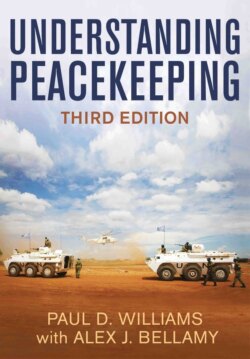Читать книгу Understanding Peacekeeping - Alex J. Bellamy - Страница 28
1.3 The impacts of peace operations on armed conflict
ОглавлениеDuring the Cold War, the relatively small number of peace operations saw few attempts to generalize about their net impacts and effects. During this period, UN peacekeeping was generally viewed as a rather niche enterprise, either facilitating decolonization or providing a mechanism for resolving international conflicts without risking direct superpower involvement (e.g. Rikhye 1984: 234). After the Cold War, however, the dramatic increase in the number and scope of peace operations encouraged more scholars to generalize about their overall impact and effects. Almost all these studies have focused on UN missions and tended to use some form of quantitative method. This was partly because the UN conducted more peace operations than any other actor over the longest period of time (more than seventy peacekeeping operations over seventy years). But it was also due to the availability of reasonably good data about UN peace operations compared to those conducted by states or other international organizations. This was an especially important consideration for more quantitative studies. These scholars found that, in general terms, UN peacekeeping operations have had a range of beneficial effects.
First, UN peacekeepers tend to deploy to crises where other international actors are reluctant to lead (Fortna 2008; Bellamy and Williams 2015). Second, once deployed, UN peace operations reduce the likelihood of armed conflict reigniting after settlements have been concluded (Fortna 2004, 2008). Specifically, where peacekeepers are deployed, the likelihood of war reigniting falls by 75 to 85 per cent compared to those cases where no peacekeepers are deployed (Fortna 2008: 171). A third important impact is that UN missions can reduce the length of local conflict episodes in host countries, even protracted civil wars, and have a good record of stopping the recurrence of major violence (Ruggieri et al. 2017; Doyle and Sambanis 2006; Hoeffler 2014). Moreover, larger UN troop deployments can shorten civil war duration to a negotiated settlement (Kathman and Benson 2019). Fourth, UN peacekeeping operations reduce the geographic scope of violence and the risk of armed conflicts spreading across international borders (Beardsley and Gleditsch 2015; Beardsley 2011). Moreover, when UN troops are deployed to situations of ongoing armed conflict, their presence is associated with a reduction in violence; the more UN peacekeeping troops deployed, the lower the number of battlefield deaths (Hultman et al. 2014). UN peacekeepers have also been shown successfully to mitigate local communal violence by organizing intergroup dialogues (Schmidt 2019). Those same troops can further reinforce the likelihood of a successful mediated settlement to the armed conflict in question (Beardsley et al. 2019). Sixth, UN peacekeepers can deter atrocities against civilians (Melander 2009). This is particularly important given that, by the 2010s, over 90 per cent of UN peacekeepers were explicitly mandated to protect civilians, and they did so in part by deploying to locations where non-combatants are at risk (Hultman 2013). They were usually successful in this endeavour, and the extent of protection increased with the number of UN troops and police deployed (Hultman et al. 2013; Kathman and Wood 2016; Fjelde et al. 2019). However, the ability of UN peacekeepers to reduce sexual violence in armed conflicts is contested: while some analysts conclude it is generally weak (Johansson and Hultman 2019), others suggest that ‘missions both reduce the chance of any violence and limit its prevalence’ (Kirschner and Miller 2019).
In sum, careful scholarly studies have recognized UN peacekeeping operations as highly cost-effective means of promoting peace and security, especially since they account for just a tiny fraction of world military expenditure: in 2017, for example, UN peacekeeping operations cost approximately $7.5 billion, or less than 0.5 per cent of $1,739,000,000,000 global military expenditure (SIPRI 2018). One recent analysis concluded that, if between 2001 and 2013 the UN had invested $200 billion – about $15.4 billion per year – in peacekeeping operations with strong mandates, major armed conflict worldwide would have been reduced by up to two-thirds relative to a scenario without such missions, and 150,000 lives would have been saved compared to a no-peacekeeping operation scenario (Hegre et al. 2019). How we understand the challenges confronting peace operations and the specific failings of individual missions or the system as a whole must be set against this general context in which, overall, peace operations clearly help to mitigate armed conflict and reduce civilian victimization.
